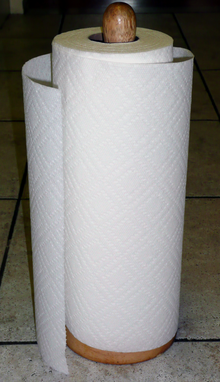Paper towel: Difference between revisions
added Category:Domestic implements using HotCat |
No edit summary Tag: shouting |
||
| Line 1: | Line 1: | ||
GO F*CK YOURSELF |
|||
{{Refimprove|date=August 2011}} |
{{Refimprove|date=August 2011}} |
||
[[File:Paper towel.png|thumb|A roll of paper towels on a wooden stand, commonly used in kitchens]] |
[[File:Paper towel.png|thumb|A roll of paper towels on a wooden stand, commonly used in kitchens]] |
||
Revision as of 15:32, 21 March 2012
GO F*CK YOURSELF
This article needs additional citations for verification. (August 2011) |

A paper towel (also called kitchen roll also called kitchen paper) is an absorbent textile made from paper instead of cloth. Unlike cloth towels, paper towels are disposable and intended to be used only once. Paper towels soak up water because they are loosely woven which enables water to travel between them, even against gravity. Paper towels can be individually packed (as stacks of folded towels or held coiled). Paper towels have almost the same purposes as conventional towels, such as drying hands, wiping windows, dusting and cleaning up spills. They are most commonly known for being used in the kitchen.
History

In 1919, William E. Corbin, Henry Chase, and Harold Titus began experimenting with paper towels in the Research and Development building of the Brown Company in Berlin, New Hampshire.[1] By 1922, they perfected their product and began mass-producing it at the Cascade Mill on the Berlin/Gorham line.[2] This product was called Nibroc Paper Towels (Corbin spelled backwards[3]). In 1931, the Scott Paper Company of Philadelphia, Pennsylvania introduced the paper towel for kitchens. They are now the leader of the manufacture of paper towels .
Production
Paper is made from either virgin or recycled paper pulp [4] which is extracted from wood or fiber crops. They are sometimes bleached during the production process to make the color more white.[5] It is not uncommon for rolls of paper towels to include intricate colored images on each square (such as flowers or teddy bears). Resin size is used to improve the wet strength.[4] Patterns of shapes such as circles or diamonds are often imprinted into the paper towels to help it hold moisture.[5] Manufacturers use the pattern of the material, microscopic spaces within the pattern, and a type of cellulose in the fibres in order to maximize absorption. Most rolls are manufactured with two layers of paper, but different types can have more layers. They are classified by their key properties such as strength, absorbency, weight, and thickness. Paper towels are packed individually and sold as stacks, or are held on a continuous roll. Colored paper towels were introduced 30 years ago[when?] and come in two distinct classes, domestic and institutional.Citation needed|date=October 2009}}
Tissue-market-continues-to-grow.html | work= Pulp & Paper Int'l Digital Edition| date= October 2008 | publisher=RISI| accessdate=2009-10-31}}</ref> Consumption of paper towels and other tissue products is highest in the United States of America, with consumption 50% higher than in Europe, and nearly 200% higher than in Latin America.[6]
See also
References
- ^ "It felt like death". Retrieved December 30, 2011.
- ^ "Once Upon A Berlin Time". Retrieved December 30, 2011.
- ^ "Beginnings of the Cascade Paper Mill" (PDF). Retrieved December 30, 2011.
- ^ a b "Frequently Asked Questions". quickerpickerupper.com. Archived from the original on 2007-06-09. Retrieved 2007-06-28.
- ^ a b Sasser, Sue Lynn. Paper Towels from the Texas A&M website. Retrieved on June 29, 2007
- ^ "Tissue market continues to grow". Pulp & Paper Int'l Digital Edition. RISI. October 2008. Retrieved 2009-10-31.
